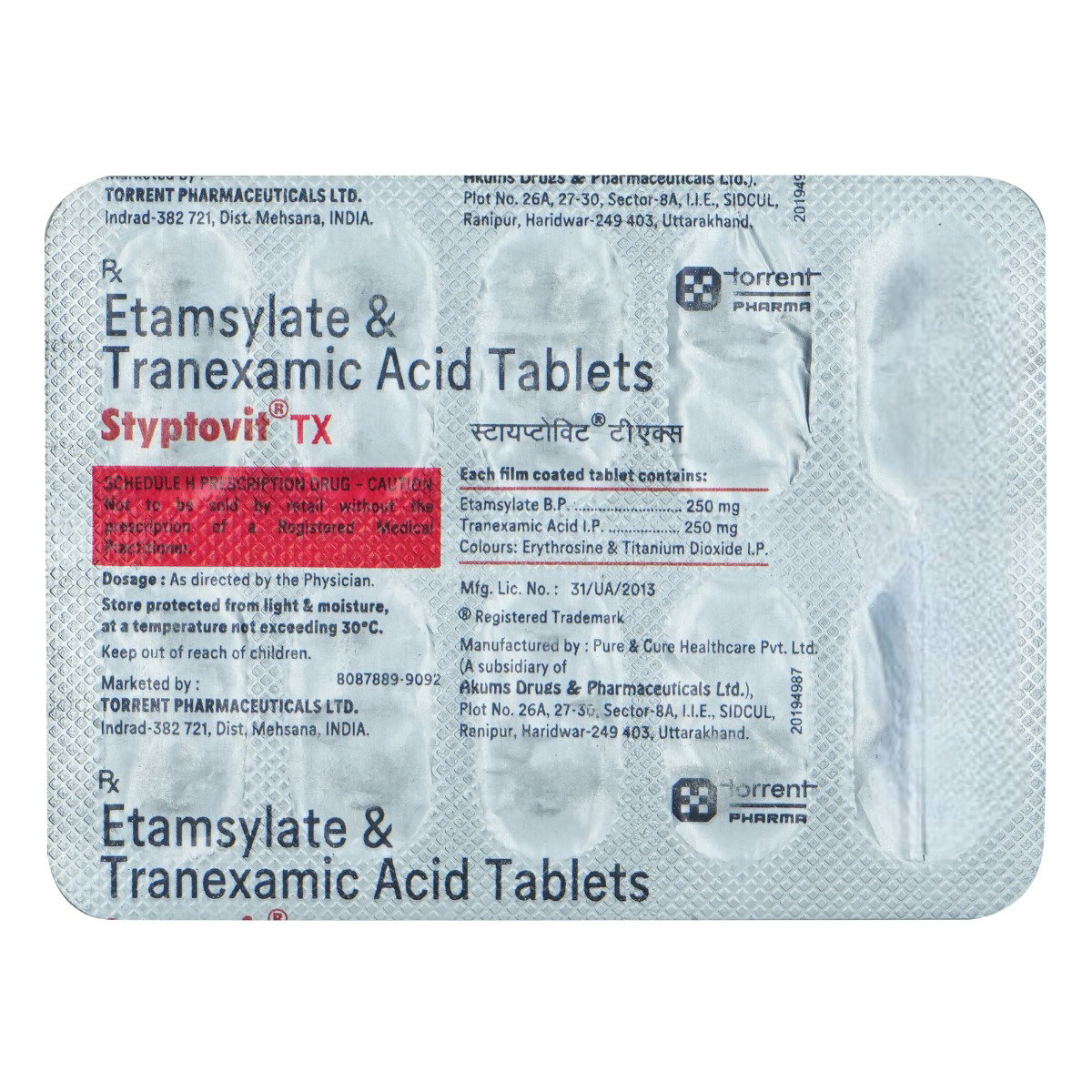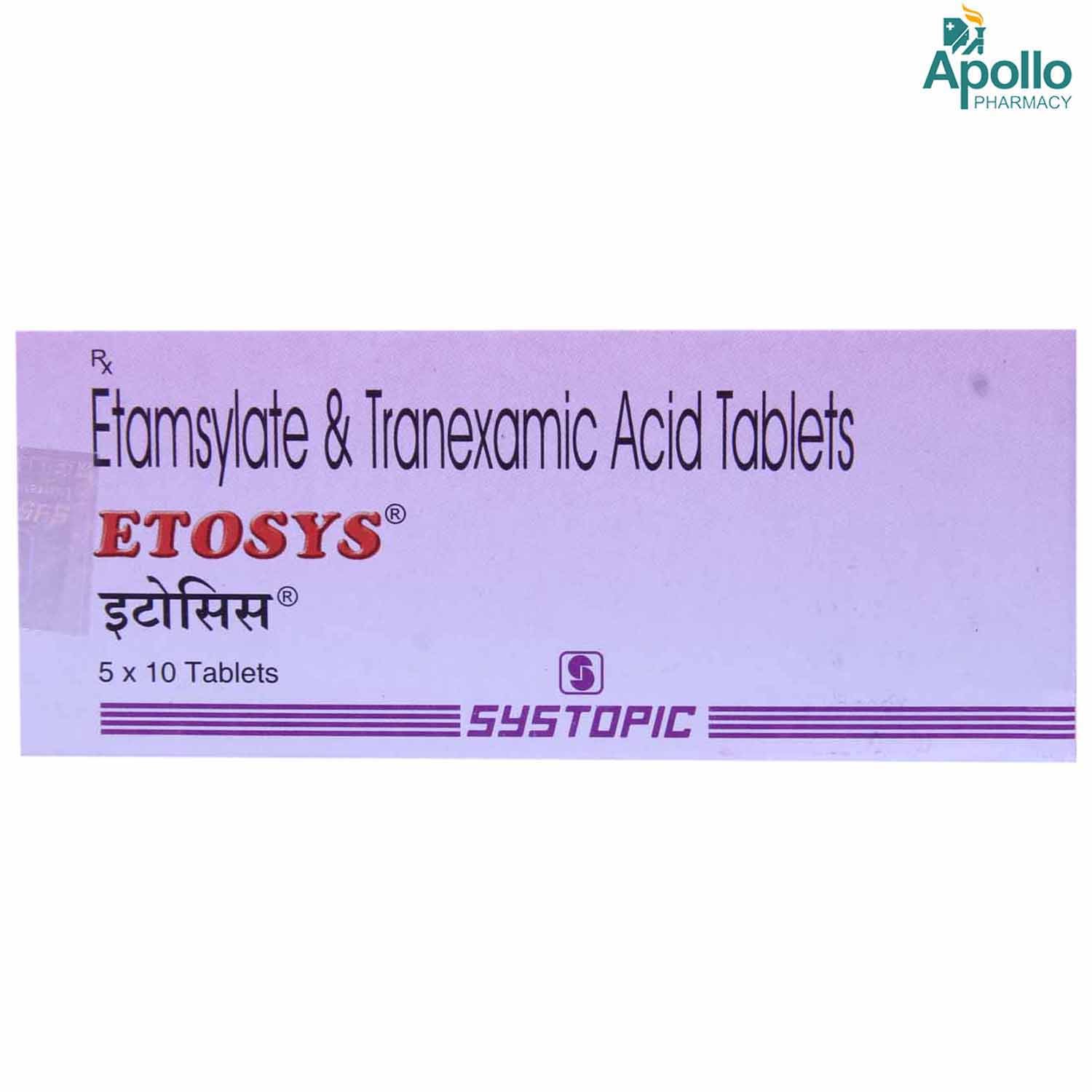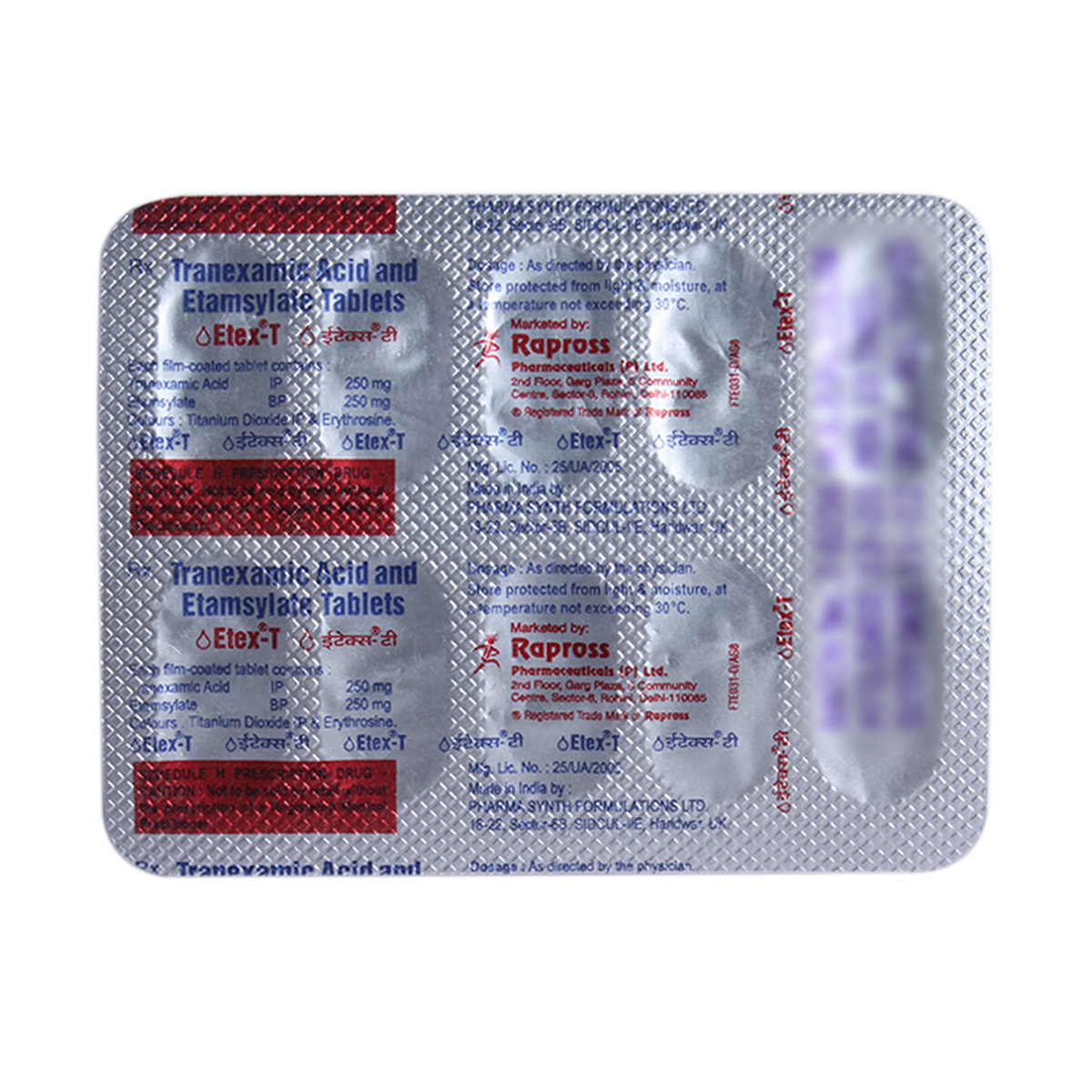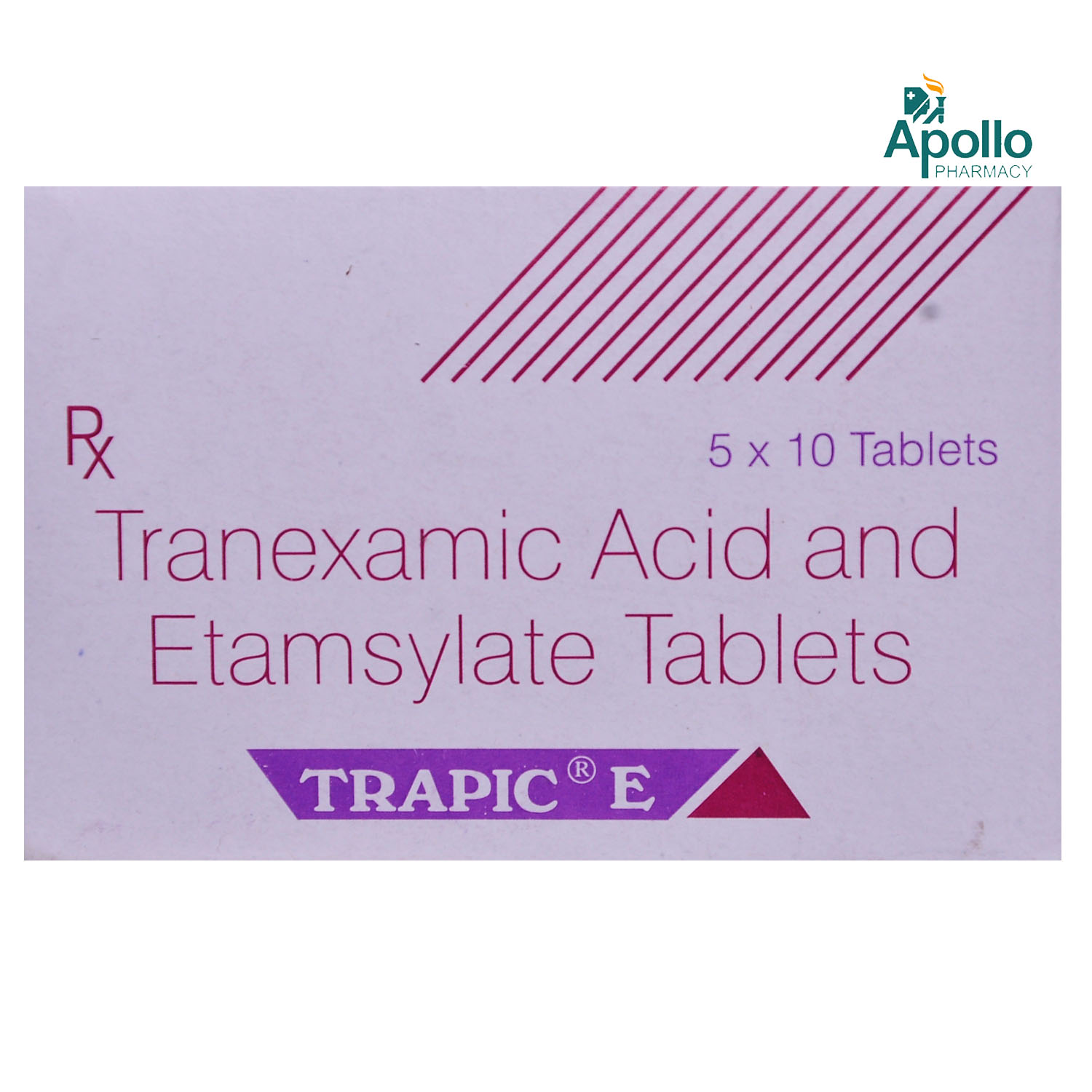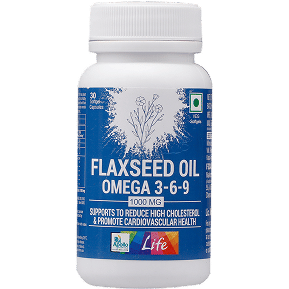Tranostat-E Tablet


MRP ₹247
(Inclusive of all Taxes)
₹37.0 Cashback (15%)
know your delivery time
Provide Delivery Location
Composition :
Manufacturer/Marketer :
Consume Type :
Expires on or after :
Return Policy :

Secure Payment

Trusted by 8 Crore Indians

Genuine Products
Therapeutic Class
Country of origin
Manufacturer/Marketer address
Disclaimer
Alcohol
Safe if prescribed
Consumption of alcohol may worsen your health condition as it may increase the risk of side-effects.
Pregnancy
Consult your doctor
Tranostat-E Tablet is a category B medicine and may not show any toxic effects to the fetus. However, it should be used with caution in pregnant women to avoid unwanted risks and only when prescribed by a doctor.
Breast Feeding
Consult your doctor
Tranostat-E Tablet may get secreted in breast milk in very low amounts. However, it should be used with caution in breastfeeding mothers to avoid unwanted risks and only when prescribed by a doctor.
Driving
Safe if prescribed
Tranostat-E Tablet may not affect your ability to drive.
Liver
Consult your doctor
Tranostat-E Tablet is probably safe in patients with liver diseases. Consult your doctor for further advice.
Kidney
Consult your doctor
Tranostat-E Tablet should be used with caution in patients with kidney diseases. The dose may have to be adjusted by your doctor.
Children
Safe if prescribed
Tranostat-E Tablet is not recommended for use in children.
Product Substitutes
About Tranostat-E Tablet
Tranostat-E Tablet belongs to the class of medications called ‘Antihemorrhagic agents’ used to treat menorrhagia. Menorrhagia is a condition characterized by heavy or prolonged bleeding during menstrual periods. You are said to have menorrhagia if the bleeding is heavy to disrupt your daily activities, soaking one or more sanitary pads or tampons every hour for several consecutive hours, bleeding for more than a week, and experiencing symptoms such as fatigue, weakness, pale face, and shortness of breath. It is also used to stop postoperative hemorrhage (excessive bleeding after a surgical procedure), and local fibrinolysis (abnormal breakdown of blood clots)
Tranostat-E Tablet is a combination of two medicines: Tranexamic acid and Etamsylate. Tranexamic acid belongs to the class of ‘anti-fibrinolytic agents’ which acts by regulating the breakdown of blood clots. It blocks the release and action of plasmin, an enzyme essential for the breakdown of clots present in the blood. Etamsylate is a hemostatic agent (prevents bleeding). It increases the ability of platelets to stick together (platelet adhesion) and form blood clots. It inhibits the action of chemical substances that cause the breakdown of platelets. These effects help to decrease abnormal bleeding.
You should take this medicine as prescribed by your doctor. Tranostat-E Tablet may cause side-effects such as nausea, vomiting, diarrhea, stomach pain, fever, chills, rash, severe headache, back or joint pain, muscle pain, difficulty moving, and runny or stuffy nose. These side-effects usually go away without any treatment. If you develop any other serious side-effects such as vision problems while using Tranostat-E Tablet , consult your doctor immediately.
Do not take Tranostat-E Tablet if you are allergic to Tranexamic acid, Etamsylate, and any other ingredients present in it. Do not take this medicine if you have a history of kidney failure, thrombosis (formation of blood clots in the blood vessels), disseminated intravascular coagulation (a disease where blood clots form throughout your body), porphyria (a group of inherited blood disorders), and seizures (fits). Inform your doctor if you are taking birth control pills or fibrinolytic agents (medicines that dissolve blood clots). Also, inform your doctor if you are pregnant or breastfeeding.
Uses of Tranostat-E Tablet
Medicinal Benefits Mweb
Key Benefits
Tranostat-E Tablet is a combination of two medicines: Tranexamic acid and Etamsylate. Tranexamic acid belongs to the class of ‘anti-fibrinolytic agents’. It acts by regulating the breakdown of blood clots in the body. It blocks the release and action of plasmin, an enzyme essential for the breakdown of clots present in the blood. Etamsylate increases the ability of platelets to stick together (platelet adhesion) and form blood clots. It inhibits the action of chemical substances that cause the breakdown of platelets. This effect helps to slow down the abnormal bleeding.
Directions for Use
Side Effects of Tranostat-E Tablet
- Nausea (feeling sick)
- Vomiting (being sick)
- Diarrhea
- Stomach pain
- Swelling of face, lips, eyelids, tongue, hands, and feet
- Dizziness
- Headache
- Chills
- Fever
- Rash
- Pale skin
- Severe headache
- Back or joint pain
- Muscle pain
- Difficulty moving
- Difficulty breathing
- Runny or stuffy nose
Drug Warnings
You should not take this medicine until the underlying cause of menorrhagia is established. Inform your doctor if you are using birth control pills, including the patch, vaginal ring, and an intrauterine device (IUD), as there is a risk of deep vein thrombosis (a condition in which blood clot is formed in the deeper vein, mostly legs). Inform your doctor if you are using fibrinolytic agents (drugs that break blood clots) as they may interfere with the activity of Tranostat-E Tablet .
Drug-Drug Interactions
Drug-Drug Interactions
Login/Sign Up
Taking drospirenone with Tranostat-E Tablet may increase the risk of blood clot formation.
How to manage the interaction:
Taking Tranostat-E Tablet with Drospirenone is not recommended, as it can lead to an interaction but can be taken if prescribed by the doctor. However, If you suffer from chest discomfort, shortness of breath, blood in the urine, blood in the cough, sudden loss of vision, and pain, redness, or swelling in your arm or leg, consult your doctor immediately.
Taking Levonorgestrel with Tranostat-E Tablet may increase the risk of blood clot formation which can lead to serious conditions such as heart problems and kidney failure.
How to manage the interaction:
Taking Tranostat-E Tablet with Levonorgestrel may leads to an interaction but can be taken if prescribed by the doctor. However, if you experience chest pain; shortness of breath; coughing up blood; blood in the urine; sudden loss of vision; and pain, redness, or swelling in your arm or leg, consult the doctor immediately. Do not stop using any medications without talking to a doctor.
Taking Ethinylestradiol with Tranostat-E Tablet may increase the risk of blood clot formation.
How to manage the interaction:
Taking Ethinylestradiol with Tranostat-E Tablet is not recommended, as it can lead to an interaction, but can be taken if a doctor has prescribed it. However, if you suffer from chest discomfort, shortness of breath, blood in the urine, blood in the cough, sudden loss of vision, and pain, redness, or swelling in your arm or leg, consult doctor immediately. Do not stop using any medications without talking to a doctor.
Taking Medroxyprogesterone acetate with Tranostat-E Tablet may increase the risk of blood clots.
How to manage the interaction:
Taking Medroxyprogesterone with Tranostat-E Tablet is not recommended but can be taken if prescribed by a doctor. Consult your doctor immediately if you experience symptoms such as chest pain, shortness of breath, coughing up blood, blood in the urine, sudden loss of vision, and pain, redness, or swelling in your arm or leg. Do not stop using any medications without talking to your doctor.
Co-administration of Tranostat-E Tablet may cause blood clotting when taken with Etonogestrel.
How to manage the interaction:
Taking Tranostat-E Tablet with Etonogestrel is not recommended, as it can lead to an interaction but can be taken if prescribed by the doctor. However, If you suffer from chest discomfort, shortness of breath, blood in the urine, blood in the cough, sudden loss of vision, and pain, redness, or swelling in your arm or leg, consult your doctor immediately.
Using Tranostat-E Tablet together with norethindrone may increase the risk of blood clots.
How to manage the interaction:
Taking norethisterone with Tranostat-E Tablet can lead to an interaction, however, it can be taken only if a doctor has advised it. If you experience symptoms such as chest pain, shortness of breath, coughing up blood, blood in the urine, sudden loss of vision, and pain, redness, or swelling in your arm or leg, contact a doctor immediately .Do not discontinue any medications without consulting a doctor.
Co-administration of Carfilzomib with Tranostat-E Tablet can increase the risk of blood clots.
How to manage the interaction:
Taking carfilzomib with Tranostat-E Tablet is not recommended due to its increased effects, however, it can be taken only if a doctor has advised it. If you experience symptoms such as chest pain, shortness of breath, difficulty breathing, coughing up blood, sudden loss of vision, pain, and numbness or weakness on one side of the body contact a doctor immediately. Do not discontinue any medications without consulting a doctor.
Co-administration of Estramustine with Tranostat-E Tablet can increase the risk of blood clots.
How to manage the interaction:
Taking Estramustine with Tranostat-E Tablet possibly lead to an interaction, however, it can be taken only if a doctor has advised it. If you experience symptoms such as chest pain, shortness of breath, difficulty breathing, coughing up blood, sudden loss of vision, pain, and numbness or weakness on one side of the body contact a doctor immediately. Do not discontinue any medications without consulting a doctor.
Co-administration of tamoxifen with Tranostat-E Tablet can increase the risk of blood clots.
How to manage the interaction:
Although taking tamoxifen and Tranostat-E Tablet together can possibly result in an interaction, it can be taken if your doctor has prescribed it. However, consult the doctor immediately if you experience symptoms such as chest pain, shortness of breath, difficulty breathing, coughing up blood, sudden loss of vision, pain, redness or swelling in an arm or leg, and numbness or weakness on one side of the body. Do not discontinue any medications without consulting a doctor.
Co-administration of tretinoin with Tranostat-E Tablet may increase the risk of blood clots.
How to manage the interaction:
Taking tretinoin with Tranostat-E Tablet is not recommended due to its increased effects, however, it can be taken only if your doctor has advised it. If you experience symptoms such as chest pain, difficulty breathing, coughing up blood, sudden loss of vision, pain, and numbness or weakness on one side of the body contact a doctor immediately. Do not discontinue any medications without consulting a doctor.
Drug-Food Interactions
Drug-Food Interactions
Login/Sign Up
Drug-Diseases Interactions
Drug-Diseases Interactions
Login/Sign Up
Drug-Drug Interactions Checker List
- STREPTOKINASE
- UROKINASE
- RETEPLASE
- ALTEPLASE
- CHLORPROMAZINE
- TRETINOIN
- LEVONORGESTREL
Habit Forming
Special Advise
- Tranostat-E Tablet may cause an increase in body temperature in some patients. Contact your doctor immediately if you experience a high fever.
- Tranostat-E Tablet is not recommended for use in patients with a history of any disease where the eye's blood vessels are obstructed due to clot formation.
Diet & Lifestyle Advise
- Maintain a healthy weight. Stay physically active.
- Consume fresh fruits and vegetables. Avoid spicy, salty, and deep-fried foods. Eating healthy can help you to recover faster.
- Avoid tea, coffee, and cold drinks.
- Drink plenty of fluids to stay hydrated. Fluids are necessary to maintain blood flow in your body.
- Avoid the intake of alcoholic beverages as it can make you dehydrated and also can affect your sleep.
- Avoid physical and psychological stress.
- Relax in a hot bath, use a heating pad, or take herbal teas to reduce stomach cramps. Massage therapy can also help to reduce cramps.
All Substitutes & Brand Comparisons
RX
Alstat TA Tablet 10's
Albert David Ltd
₹22.5
(₹2.25 per unit)
89% CHEAPERRX
Out of StockEthored-TX Tablet 10's
Leeford Healthcare Ltd
₹165
(₹14.85 per unit)
33% CHEAPERRX
Out of StockTraxvel-Et Tablet 10's
Syndicare Lifescience
₹169
(₹15.21 per unit)
31% CHEAPER

Have a query?
Buy best Vascular System products by
Emcure Pharmaceuticals Ltd
Intas Pharmaceuticals Ltd
Lupin Ltd
Ozone Pharmaceuticals Ltd
Sun Pharmaceutical Industries Ltd
Cipla Ltd
Leeford Healthcare Ltd
Mercury Laboratories Ltd
Torrent Pharmaceuticals Ltd
FDC Ltd
Macleods Pharmaceuticals Ltd
Akumentis Healthcare Ltd
Dr Reddy's Laboratories Ltd
Indoco Remedies Ltd
Mankind Pharma Pvt Ltd
Oaknet Healthcare Pvt Ltd
Reliance Formulation Pvt Ltd
Samarth Life Sciences Pvt Ltd
Walter Bushnell
Wanbury Ltd
Abbott India Ltd
Eris Life Sciences Ltd
Galcare Pharmaceuticals Pvt Ltd
Juggat Pharma Ltd
Knoll Pharmaceuticals Ltd
Kontest Pharmaceuticals
Saf Fermion Ltd
Serdia Pharmaceuticals India Pvt Ltd
Systopic Laboratories Pvt Ltd
Themis Chemicals Ltd
Akcent Healthcare India Pvt Ltd
Alembic Pharmaceuticals Ltd
Amelia Healthcare Pvt Ltd
Canixa Life Sciences Pvt Ltd
East West Pharma India Pvt Ltd
German Remedies Ltd
Glenmark Pharmaceuticals Ltd
Ipca Laboratories Ltd
La Pristine Bioceuticals Pvt Ltd
Morepen Laboratories Ltd
Nexgen Rx Life Science Pvt Ltd
Pfizer Ltd
Rapross Pharmaceuticals Pvt Ltd
Sumac Pharma Pvt Ltd
Theia Health Care Pvt Ltd
Themis Medicare Ltd
Themis Pharmaceutical Ltd
4Care Lifesciences Pvt Ltd
Aar Ess Remedies Pvt Ltd
Aarux Pharmaceuticals Pvt Ltd
Alna Biotech Pvt Ltd
Aphia Healthcare
Aristo Pharmaceuticals Pvt Ltd
Baxter India Pvt Ltd
Bennet Pharmaceuticals Ltd
Bharat Serums and Vaccines Ltd
Biosys Pharmaceuticals Ltd
Bros Enterprises Ltd
Celebrity Biopharma Ltd
Chemo Healthcare Pvt Ltd
Cibeles Pharmaceuticals Pvt Ltd
Comed Chemicals Ltd
Conatus Healthcare Pvt Ltd
Cresha Lifesciences
Cute Care Life Sciences Pvt Ltd
Elbrit Life Sciences Pvt Ltd
Euro Biogenics
Icon Life Sciences
J B Chemicals & Pharmaceuticals Ltd
Kee Pharma Ltd
Kemiq Lifesciences Pvt Ltd
Kivi Labs Ltd
Lincoln Pharmaceuticals Ltd
Medchronic Health Care
Medgen Drugs And Laboratories Pvt Ltd
Megma Healthcare Pvt Ltd
Novartis India Ltd
Olcare Laboratories Pvt Ltd
Ornate Labs Pvt Ltd
Q Check Pharmaceuticals
Saan Labs
Stadmed Pvt Ltd
Std Pharmaceuticals Pvt Ltd
Zydus Cadila
3G Life Sciences
Accent Pharmaceuticals & Diagnostics
Adroit Biomed Ltd
Aishwarya Healthcare
Ajanta Pharma Ltd
Akesiss Pharma Pvt Ltd
Albert David Ltd
Algen Healthcare Ltd
Amazone Pharmaceuticals Pvt Ltd
Amstel Pharma Pvt Ltd
Anhox Healthcare Pvt Ltd
Apios Lifesciences Pvt Ltd
Args India Pharma Pvt Ltd
Ark Life Science Pvt Ltd
Arvincare
Aztomax Biotech
Frequently Bought Together
Customers Also Bought



